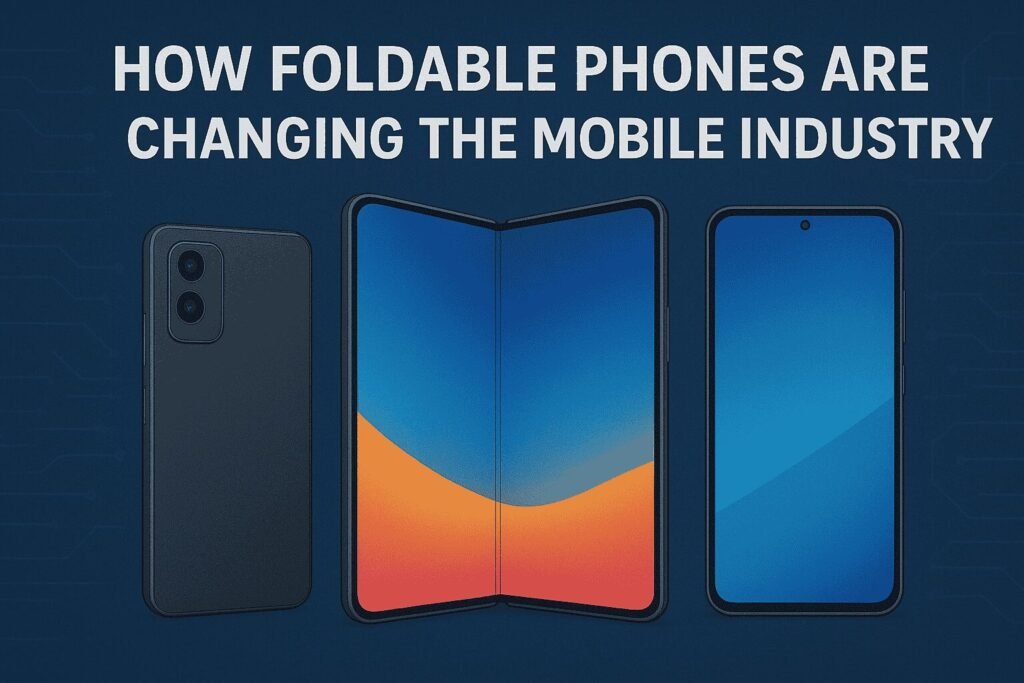
Table of Contents
Introduction: The Unfolding Revolution
For decades, the smartphone design mantra was simple: a flat, rigid glass slab that gets bigger every year. That is, until foldable phones burst onto the scene. For a decade-long perspective, read The Evolution of Smartphone Technology in the Last Decade. What was once a futuristic concept is now a tangible reality, pushing the boundaries of mobile technology and user experience. More than just a novelty, foldable devices are acting as a catalyst, fundamentally shifting how manufacturers design, market, and innovate. This article delves into the transformative impact of foldable phone technology, exploring how it’s reshaping the mobile industry from the ground up.
From Niche to Mainstream: The Evolution of Foldable Design
The journey of foldables began with clunky prototypes and eye-watering price tags. Early devices faced justified skepticism around durability, with concerns about flexible display creases and hinge mechanisms. However, rapid iteration has been staggering.
- Design Refinement: Brands like Samsung with its Galaxy Z Fold and Z Flip series, Google with the Pixel Fold, and Motorola with the Razr+ have significantly improved durability. The use of ultra-thin glass (UTG), more robust polyimide layers, and sophisticated water-resistant hinge mechanisms have alleviated many early concerns.
- Price Diversification: While still premium, the cost of entry is gradually decreasing, bringing these devices closer to a wider audience. This evolution from a proof-of-concept to a polished product category is the first major industry shift, proving there’s a viable market for form factors beyond the traditional slate.
See how display innovation is evolving in The Rise of Foldable and Flexible Display Technology.
Redefining User Experience: The Power of Two Form Factors
The most immediate impact of foldable phones is on the user. They uniquely solve a core contradiction in modern smartphones: the desire for a large screen versus the need for pocketable portability.
1. The Ultimate Multitasking Machine
Phones like the Samsung Galaxy Z Fold 5 and Google Pixel Fold essentially function as a phone and a tablet in one device. Their inner screens provide a canvas for advanced multi-window app functionality.
- True Multi-Tasking: Users can run three apps simultaneously side-by-side, drag and drop content between them, and use persistent taskbars for effortless app switching. This transforms the device from a consumption-focused gadget into a potent productivity tool capable of replacing a laptop for light work.
2. Innovative Use Cases and Content Consumption
The different form factors inspire new ways to interact with content.
- Flex Mode: Popularized by clamshell-style flip phones, the device can be partially folded to act as its own stand. This enables hands-free video calls, easier photography, and watching videos without a tripod.
- Immersive Media: Unfolding a device to reveal a near-tablet-sized screen is a game-changer for watching movies, playing mobile games, and reading. The larger foldable display offers an immersive experience a standard phone cannot match.
The Ripple Effect: How Foldables Are Forcing Industry-Wide Change
The emergence of foldables has sent ripples throughout the entire mobile ecosystem, forcing competitors to adapt and innovate.
1. Fierce Competition and Market Diversification
The success of early foldables has spurred intense competition. Almost every major Android manufacturer now has or is developing a foldable, creating a new high-end market segment. This has broken the monotony of iterative annual upgrades, pushing companies to take bigger design risks.
2. Software Innovation and Ecosystem Development
A new hardware form factor is useless without software to support it. Google has deeply integrated foldable phone support into Android, with features like screen continuity (seamlessly transitioning an app from the cover screen to the main screen) and optimized app layouts. This forces app developers to rethink their UI/UX for adaptable, larger screens, much like they had to for tablets.
3. The “De-Facto” Flagship and Premium Pricing
Foldables are increasingly positioned as the true flagship devices, often boasting the latest chipsets, best cameras, and most advanced materials. This reinforces a tiered market structure, solidifying the “ultra-premium” segment and influencing pricing strategies across the board.
Challenges and Considerations: The Road Ahead for Foldable Technology
Despite the progress, hurdles remain before foldables achieve mass adoption.
- Durability and Longevity: While improved, the folding screen is still inherently more fragile than a rigid one. Concerns about long-term wear, the visibility of the crease, and the cost of repairs persist.
- Battery Life and Weight: Powering a large display and a more complex mechanism is demanding. Manufacturers must balance battery capacity with the added weight and thickness of these devices, which are still heavier than their slab-style counterparts.
- App Ecosystem Fragmentation: Not all apps are perfectly optimized for the unique aspect ratios and screen transitions of foldables, leading to a sometimes inconsistent experience.
The Future is Flexible: What’s Next?
The foldable revolution is just beginning. We can expect to see:
- New Form Factors: Rollable phones, stretchable screens, and dual-fold devices are already in prototyping, promising even more versatility.
- Material Science Breakthroughs: Advances in flexible display technology, including more durable glass composites and self-healing polymers, will further improve reliability.
- Mainstream Adoption: As costs decrease and durability increases, foldables will move from a luxury item to a mainstream choice for consumers.
Conclusion: More Than Just a Gimmick
Foldable phones are far more than a passing trend. They represent the most significant structural shift in mobile design in over a decade. By challenging the status quo, they are forcing the entire industry—from hardware engineers to software developers—to think differently. They are creating new user experiences, redefining productivity on the go, and reinvigorating a market that had become predictable. While challenges remain, the foldable phone is undoubtedly unfolding a new, exciting chapter for the mobile industry.
